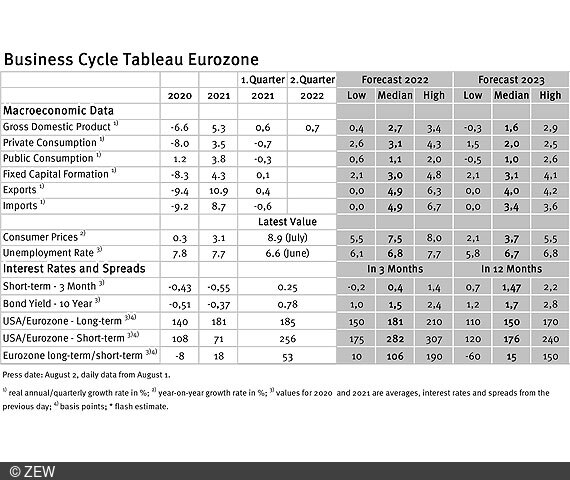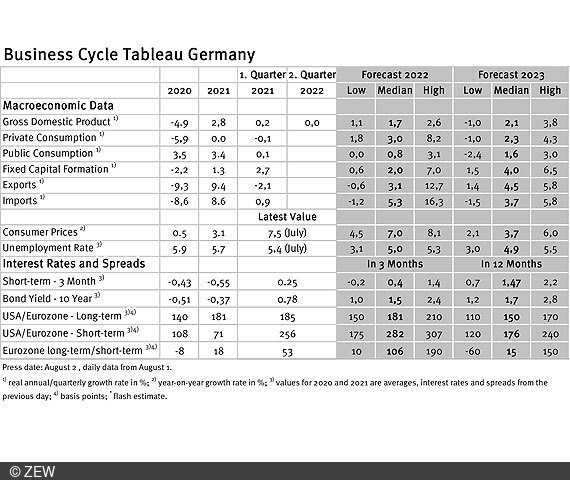Economic Situation Becomes Uneasy
Business Cycle Tableaus by ZEW and Börsen-ZeitungEconomic Experts Lower Growth Forecast and Raise Inflation Outlook
Economic experts expect lower economic growth for the eurozone and Germany than was forecast a few weeks ago. At the same time, inflation forecasts have been raised, which are now far above the European Central Bank’s target value. This is the result of the business cycle tableaus by ZEW Mannheim and the German daily newspaper, Börsen-Zeitung.
Economic growth in the eurozone was surprisingly strong at 0.7 per cent quarter-on-quarter, after 0.6 per cent in the first quarter. In contrast, economic growth in Germany slowed down significantly. After a strong first quarter (0.8 per cent compared to the previous quarter), the seasonally and calendar-adjusted gross domestic product (GDP) remained at the same level.
GDP forecasts continue to fall
For this year and especially next year, the experts are less optimistic than they were a few weeks ago. For the eurozone, the GDP forecast for 2023 has been revised downwards from 2.3 per cent to 1.6 per cent. For the German economy, they still expect growth of 1.7 per cent for 2022 (previously: 2.1 per cent); for 2023, the forecast has dropped from 2.5 per cent to now 2.1 per cent.
No decline in inflation in sight
Inflation forecasts have been raised significantly for both the eurozone and Germany. For the eurozone, the inflation forecast for 2022 is now 7.5 per cent (previously: 6.8 per cent) and for Germany 7.0 per cent (previously: 6.5 per cent). As before, the forecasters expect a sharp bend in the inflation trend next year, but they are less confident that inflation will decline. In 2023, inflation in the eurozone and Germany is expected to be well above the ECB’s target, at 3.7 per cent (previously: 2.7 per cent). The time for hesitant interest rate hikes is thus over.
Interest rate hikes expected, but real interest rates still in negative territory
For this reason, the interest rate forecasts continue to rise considerably. For the current year, experts predict only a slight increase to 0.4 per cent. In the coming year 2023, however, short-term interest rates are expected to rise to a median of about 1.5 per cent. This would correspond to an increase of 125 basis points from today’s level. Long-term interest rates are also forecast to rise further, to 1.5 per cent (previously: 1.2 per cent) this year and 1.7 per cent (previously: 1.4 per cent) next year. Despite these expected interest rate rises, however, the (implicitly) projected real interest rates remain well in negative territory in both years. The interest rate forecasts also show that the interest rate differential between the eurozone and the USA is likely to narrow in 2023, which will provide stability for the euro exchange rate.
Business cycle tableaus by ZEW and Börsen-Zeitung
In cooperation with Börsen-Zeitung, ZEW has been publishing monthly business cycle tableaus for Germany and the eurozone with economic key figures and forecasts since 2013. Numerous banks and institutes publish reports on the current and prospective economic situation at different intervals. The information relevant for the tableau is filtered out of these publications to compute a median, minimum and maximum of the available forecasts for the current and subsequent year.
The monthly tableaus show current GDP forecasts, its main components, consumer prices, industrial production, unemployment rate, short- and long-term interest rates, and interest rate spreads. The focus of the tableaus lies on national business cycle reports, which are complemented with forecasts from international banks and institutes. The tableau for the eurozone is enhanced by data from European banks and institutes.

